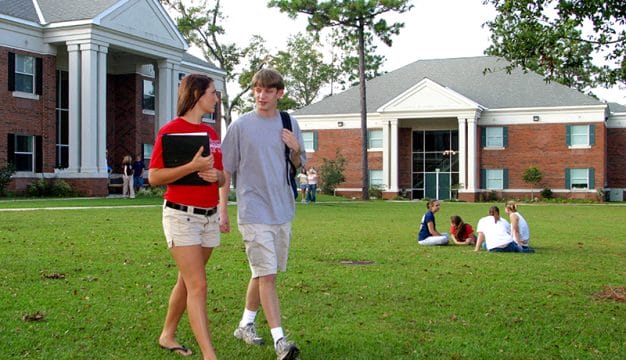Athens State University
Athens State University (ASU), located in Athens, Limestone County, is the oldest continuously operating public institution of higher education in the state of Alabama. It is unique in that it offers the final two years of a college curriculum, which complement the first two years’ curriculum offered by the rest of the state’s community college system. The university plays host to the Tennessee Valley Old Time Fiddlers Convention every October.
 Athens State University
ASU began as a private academy in 1821, when Alabama Supreme Court Judge John McKinley donated land to the city of Athens to establish the Athens Female Academy. The initial institution, which began classes in January 1822, consisted of a four-room school house, with 24-year-old Baptist minister Daniel Perrin Bestor as head. Its progressive goal was to provide elementary, secondary, and college-level instruction to girls and young women. In the early nineteenth century, college-level instruction was known as academy education, although some students graduated at a significantly younger age than do present-day college students. Students were primarily the daughters of local well-to-do families who were able to afford the school’s tuition.
Athens State University
ASU began as a private academy in 1821, when Alabama Supreme Court Judge John McKinley donated land to the city of Athens to establish the Athens Female Academy. The initial institution, which began classes in January 1822, consisted of a four-room school house, with 24-year-old Baptist minister Daniel Perrin Bestor as head. Its progressive goal was to provide elementary, secondary, and college-level instruction to girls and young women. In the early nineteenth century, college-level instruction was known as academy education, although some students graduated at a significantly younger age than do present-day college students. Students were primarily the daughters of local well-to-do families who were able to afford the school’s tuition.
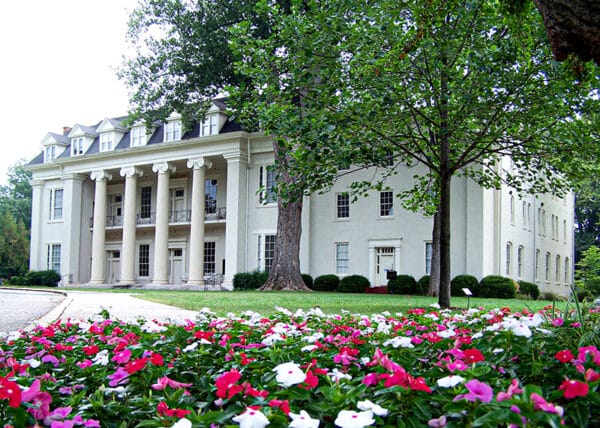 Founders Hall
During the summer of 1842, the trustees of the Athens Female Academy and a group of the city’s residents decided to work toward affiliating the school with the Methodist Church, which was developing its own system of higher education. The goal was to attract boarding students from a much wider geographical area and increase enrollment and expand the curriculum. In October 1842, the Tennessee Conference of the Methodist Episcopal Church held its annual meeting in Athens, and local representatives successfully petitioned the organization to sponsor the academy. At the same time, various local families donated the money to build Founders Hall, the oldest building on the current campus. The institution was renamed Athens Female Institute of the Tennessee Annual Conference, with Methodist minister Richard Henderson Rivers serving as its first president. The Alabama Legislature formally recognized that name change in January 1843. The new institute offered elementary, preparatory, and collegiate curricula in the liberal arts, a focus that has characterized the college through most of its history.
Founders Hall
During the summer of 1842, the trustees of the Athens Female Academy and a group of the city’s residents decided to work toward affiliating the school with the Methodist Church, which was developing its own system of higher education. The goal was to attract boarding students from a much wider geographical area and increase enrollment and expand the curriculum. In October 1842, the Tennessee Conference of the Methodist Episcopal Church held its annual meeting in Athens, and local representatives successfully petitioned the organization to sponsor the academy. At the same time, various local families donated the money to build Founders Hall, the oldest building on the current campus. The institution was renamed Athens Female Institute of the Tennessee Annual Conference, with Methodist minister Richard Henderson Rivers serving as its first president. The Alabama Legislature formally recognized that name change in January 1843. The new institute offered elementary, preparatory, and collegiate curricula in the liberal arts, a focus that has characterized the college through most of its history.
Enrollment rose from 80 students in 1843 to almost 200 but leveled off in the 1850s. In 1858, Jane Hamilton Childs, head of the Huntsville Female College, was appointed president. She renamed the school the Athens Collegiate Institute and kept it functioning during the turbulent Civil War years, even as the town was besieged by Union troops. When Childs retired in 1869, the school largely reverted to educating the daughters of area families who could afford the tuition. In 1870, the North Alabama Conference of the Methodist Church South was established and took control of the school, renaming it the North Alabama Female College. In 1872, the Alabama Legislature formally recognized the school’s name as the Athens Female Institute. In 1889, the legislature once again changed the name to Athens Female College. Efforts to establish a significant endowment for the college continued from 1869 to 1904 without success. Low enrollment and financial troubles plagued the school during the latter part of the nineteenth century.
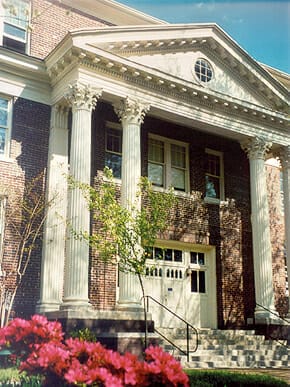 McCandless Hall
In 1904, Mary Norman Moore became the president of the college. During her tenure, the school abandoned elementary education to focus on developing a modern higher education curriculum. In 1915, the school was renamed the Athens College for Young Women and was usually referred to as Athens College. Moore stepped down in 1916 upon her marriage (and became known as Mary Moore-McCoy) but returned after being widowed to serve a second term as president from 1925 to 1930, making her the only person to serve as president of Athens twice. In 1910, the college gained Class B status from the Methodist Conference, which was based on having at least seven full-time faculty and annual endowment income of $5,000 or more. Accreditation by the Southern Association of Colleges and Schools followed in 1911, and in 1913 the Methodist Conference raised the college to Class A status, after it achieved the minimum endowment of $100,000. Moore also hired concert pianist Kate McCandless in 1911 to develop the music program, which for many years after was a centerpiece of the curriculum.
McCandless Hall
In 1904, Mary Norman Moore became the president of the college. During her tenure, the school abandoned elementary education to focus on developing a modern higher education curriculum. In 1915, the school was renamed the Athens College for Young Women and was usually referred to as Athens College. Moore stepped down in 1916 upon her marriage (and became known as Mary Moore-McCoy) but returned after being widowed to serve a second term as president from 1925 to 1930, making her the only person to serve as president of Athens twice. In 1910, the college gained Class B status from the Methodist Conference, which was based on having at least seven full-time faculty and annual endowment income of $5,000 or more. Accreditation by the Southern Association of Colleges and Schools followed in 1911, and in 1913 the Methodist Conference raised the college to Class A status, after it achieved the minimum endowment of $100,000. Moore also hired concert pianist Kate McCandless in 1911 to develop the music program, which for many years after was a centerpiece of the curriculum.
Eugene R. Naylor, the first male president who was an academic rather than a clergyman, took the helm during the summer of 1930. That same year, Naylor decided to offset the chronic under-enrollment and the effects of the Great Depression by admitting male students, despite the school’s renown as an elite women’s institution. In recognition of this change, in 1939 the Alabama Legislature officially shortened the name of the school to Athens College.
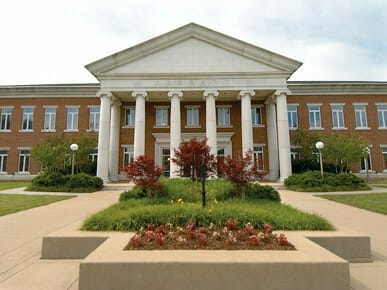 Athens State University Library
Building on the foundations established by Moore, under Naylor’s leadership Athens College increased its reputation for the quality of its academic programs. After Naylor resigned as president in 1949, succeeding presidents strove to expand and develop the curriculum and programs with varying levels of success. In 1970, Sidney E. Sandridge became president of Athens College at a time when the deteriorating finances of the college were reaching a crisis. The state of Alabama assumed ownership of Athens College in 1975. After a series of intense debates and negotiations in the state legislature, the college’s name was changed to Athens State College and the curriculum was refocused to serve as the two-year upper-division college within Alabama’s community college system. All students attending Athens State are transfers from either community colleges or four-year institutions. No general education courses are offered.
Athens State University Library
Building on the foundations established by Moore, under Naylor’s leadership Athens College increased its reputation for the quality of its academic programs. After Naylor resigned as president in 1949, succeeding presidents strove to expand and develop the curriculum and programs with varying levels of success. In 1970, Sidney E. Sandridge became president of Athens College at a time when the deteriorating finances of the college were reaching a crisis. The state of Alabama assumed ownership of Athens College in 1975. After a series of intense debates and negotiations in the state legislature, the college’s name was changed to Athens State College and the curriculum was refocused to serve as the two-year upper-division college within Alabama’s community college system. All students attending Athens State are transfers from either community colleges or four-year institutions. No general education courses are offered.
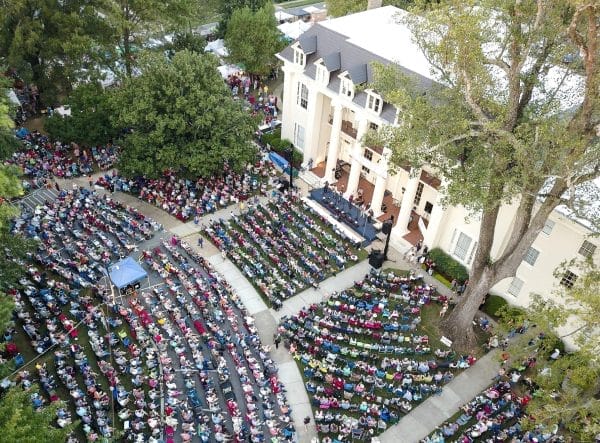 Audience at Founder’s Hall
In 1981, Sandridge was succeeded by Calhoun Community College president James Chasteen and then by Jerry F. Bartlett in 1990. During his term as president, Bartlett oversaw the expansion of distance learning technology, which allowed Athens State to expand its outreach to traditionally underserved students. In 1998, the college was renamed Athens State University. In 2009, Robert K. Glenn became president, following in the footsteps of his great grandfather Edgar M. Glenn, who served as president from 1902-1904. In 2019, business professor Philip Way became president of the university.
Audience at Founder’s Hall
In 1981, Sandridge was succeeded by Calhoun Community College president James Chasteen and then by Jerry F. Bartlett in 1990. During his term as president, Bartlett oversaw the expansion of distance learning technology, which allowed Athens State to expand its outreach to traditionally underserved students. In 1998, the college was renamed Athens State University. In 2009, Robert K. Glenn became president, following in the footsteps of his great grandfather Edgar M. Glenn, who served as president from 1902-1904. In 2019, business professor Philip Way became president of the university.
Athens State offers more than 30 undergraduate majors through three colleges: Business, Arts and Sciences, and Education. In the fall semester of 2010, Athens State University enrolled more than 3,700 students. It employs a full-time faculty and staff of approximately 250 people and has an annual budget of approximately $58 million. Intercollegiate sports were ended during the 2003-04 academic year, although the university’s mascot remains Hebrew the Bear.
Students have the opportunity to participate in more than 35 clubs and organizations on campus such as the Student Government Association, the Health and Science Career Club, and the Mathematics and Computer Science Club. Major college honor societies such as Sigma Tau Delta, Psi Chi, Phi Alpha Theta, and Kappa Delta Pi have chapters on campus also.
Additional Resources
McLin, Elva Bell. The History of Athens State College 1821-1994. Revised edition. Nashville, Tenn.: Rand-McNally, 1994.
———. Madame Childs: The Lady and the Legend. Nashville, Tenn.: Rand-McNally, 1992.
Moore, Mary Norman. History of Athens College. Birmingham, Ala.: Press of the American Publishing Company, 1916.
Naylor, Ralph N. “A Brief History of Athens College.” Master’s thesis, Vanderbilt University, 1937.
